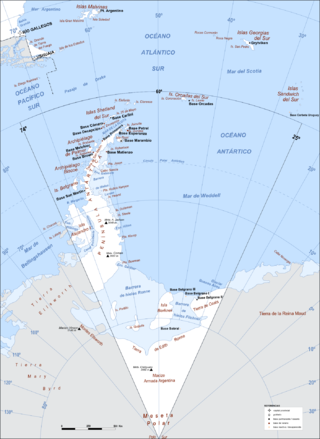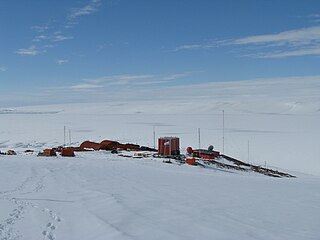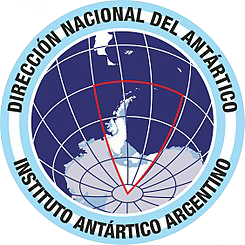
The South Orkney Islands are a group of islands in the Southern Ocean, about 604 km (375 mi) north-east of the tip of the Antarctic Peninsula and 844 km (524 mi) south-west of South Georgia Island. They have a total area of about 620 km2 (240 sq mi). The islands are claimed both by Britain, and by Argentina as part of Argentine Antarctica. Under the 1959 Antarctic Treaty, sovereignty claims are held in abeyance.

Base Orcadas is an Argentine scientific station in Antarctica, and the oldest of the stations in Antarctica still in operation. It is located on Laurie Island, one of the South Orkney Islands, at 4 meters (13 ft) above sea level and 170 meters (558 ft) from the coastline. Established by the Scottish National Antarctic Expedition in 1903 and transferred to the Argentine government in 1904, the base has been permanently populated since, being one of six Argentine permanent bases in Argentina's claim to Antarctica, and the first permanently inhabited base in Antarctica.

Argentine Antarctica is an area on Antarctica claimed by Argentina as part of its national territory. It consists of the Antarctic Peninsula and a triangular section extending to the South Pole, delimited by the 25° West and 74° West meridians and the 60° South parallel. This region overlaps with British and Chilean claims in Antarctica. None of these claims have widespread international recognition.

Belgrano II Base is a permanent, all year-round Argentine Antarctic base and scientific research station named after General Manuel Belgrano, one of the Libertadores and the creator of the Argentine Flag. It is located on Bertrab Nunatak on the Confín Coast, Coats Land.

Carlini Base, formerly known as Jubany Base, is an Argentine permanent base and scientific research station named after scientist Alejandro Ricardo Carlini. It is located on Potter Cove, King George Island, in the South Shetland Islands.

Marambio Station is a permanent, all year-round Argentine Antarctica station named after Vice-Commodore Gustavo Argentino Marambio, an Antarctic aviation pioneer. It is located in Marambio Island, Graham Land, Antarctic Peninsula, some 100 km (60 mi) from the coastal civilian village of Esperanza.

Brown Station is an Argentine Antarctic base and scientific research station named after Admiral William Brown, the father of the Argentine Navy. It is located on Sanavirón Peninsula along Paradise Harbor, Danco Coast, in Graham Land, Antarctic Peninsula.

San Martín Base is a permanent, all year-round Argentine Antarctic base and scientific research station named after General José de San Martín, the Libertador of Argentina, Chile and Perú. It is located on Barry Island, Marguerite Bay, Antarctic Peninsula.

The Chilean Antarctic Territory, or Chilean Antarctica, is a part of West Antarctica and nearby islands claimed by Chile. It comprises the region south of 60°S latitude and between longitudes 53°W and 90°W, partially overlapping the Antarctic claims of Argentina and of the United Kingdom. It constitutes the Antártica commune of Chile.

Cámara Base is an Argentine Antarctic base and scientific research station named after Frigate Lieutenant Naval Aviator Juan Ramón Cámara. It is located in the northern foothills of La Morenita Hill, at Menguante Cove in Half Moon Island off the east coast of Livingston Island in the South Shetland Islands, Antarctica.

The Instituto Antártico Argentino is the Argentine federal agency in charge of orientating, controlling, addressing and performing scientific and technical research and studies in the Antarctic.

Ellsworth Scientific Station was a permanent, all year-round originally American, then Argentine Antarctic scientific research station named after American polar explorer Lincoln Ellsworth. It was located on Gould Bay, on the Filchner Ice Shelf.

Matienzo Base is an Argentine Antarctic base and scientific research station named after Lieutenant Benjamín Matienzo, an Argentine aviation pioneer. It is located in Larsen Nunatak, one of the Foca Nunataks, in Graham Land, Antarctic Peninsula.

Primavera Base is an Argentine Antarctic base and scientific research station. It is located on Primavera Cape, Cierva Cove, on San Martín Land, Antarctic Peninsula.

Melchior Base is an Argentine Antarctic base and scientific research station. It is located on Gamma Island, Melchior Islands, Dallmann Bay, in Palmer Archipelago on Bellingshausen Sea, Antarctic Peninsula.

The Brazilian Antarctic Program is a program of the Brazilian Navy which has presence in the continent of Antarctica. It coordinates research and the operational support for research in the region. It currently maintains a year-round research station in Antarctica, as well as several seasonal field camps. It also maintains two research vessels that sail in the Antarctic waters.
Belgrano I Base was a permanent, all year-round Argentine Antarctic base and scientific research station, located on Piedrabuena Bay on the Filchner Ice Shelf. It was named after General Manuel Belgrano, one of the Libertadores and the creator of the Argentine flag.

Hernán Pujato was an Argentine military general, diplomat, and explorer. He founded the first Antarctica bases for his country, and founded the Instituto Antártico Argentino. Through this institute, Pujato attempted to colonize Antarctica, with the assistance of President Juan Perón.

Dallmann Laboratory is an on-site summer laboratory on King George Island, South Shetland Islands, at the tip of the Antarctic Peninsula, adjacent to the Argentinian Carlini Base with shared logistics. It is operated by the Alfred Wegener Institute for Polar and Marine Research in cooperation with the Netherlands and Instituto Antártico Argentino. It is named after the polar sea explorer Eduard Dallmann.

LRA36 Radio Nacional Arcángel San Gabriel, is a radio station that transmits on shortwave on 15476 kHz in the 19 meter band and on 96.7 FM, from Esperanza Base, Antarctica. LRA36 is one of the southernmost radio stations in the world.




















